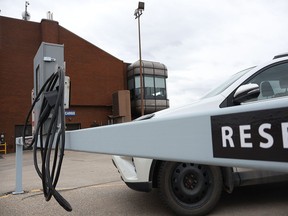Grande Prairie region experiences EV infrastructure and market growth
With the recent rise in Electric Vehicles (EVs) in Canada, smaller municipalities in the Peace Country region including Grande Prairie are trying to keep up.

Article content
With the recent rise in Electric Vehicles (EVs) in Canada, smaller municipalities in the Peace Country region including Grande Prairie are trying to keep up.
The Canadian government announced plans in December to eliminate solely gas-powered vehicles on the market by 2035 as part of a larger plan to cut carbon emissions.
Canada’s federal carbon tax also increased by 23% on April 1 with one litre of gas being taxed at a rate of 17.6 cents. This undoubtedly increased interest in EVs as infrastructure continues to grow to meet greater demands.
“Every government action has to have an economic, social and environmental benefit. It doesn’t need to be balanced, it just needs to somehow benefit each one of those,” says Kent Rathwell, CEO of Sun Country Highway, a company that installs charging stations across the country. “Gas pumps aren’t cheap. They cost a lot of money to maintain. They’re not like the old farm pumps where you just flip the switch they turned on. There’s a lot of digital electronics in them.”
There are currently three levels of EV chargers. Level-1 chargers which are typically provided by EV manufacturers charge around 4 km/h. Level-2 chargers which can be purchased and owned by EV owners charge at a faster rate of around 40 km/h. Level-3 chargers are the newest and most complex charging stations which are often located on highways and can charge at rates of 80 km/h.
Level-3 charging stations are planned to be opened in Valleyview and Whitecourt by “spring 2024” but are not currently operational.
“Level-3 prices will come down as chargers are deployed but most should really only be used when you need fleets that are that are like police vehicles, ambulances and fire trucks,” says Rathwell. “For delivery trucks that are just overnight they don’t need Level-3 and ideally, people charge in their garage or outside their house. That’s also beneficial to the grid which helps everybody keep costs down.”
Most EV owners use home chargers which is often the best option in the Peace Country region due to the diminishing numbers of public chargers in rural areas.
“Many people don’t realize that a regular 120v plug-in such as for your curling iron will charge an EV. If you have a NEMA14-50, the plugin for a welder, washer, dryer or fridge, you’ll get about 40km/h charging at home,” says Remi Tardif, an EV owner in Peace River. “Yes, higher energy bills suck but an additional $50 to ATCO is better than $250 to Esso/Shell, no? If my EV is charged up enough, I can go from Northern Alberta and get to Edson or Hinton or south of the Peace Country, for future charging. The vehicle can easily handle 200-300 km, even in winter.”
Another concern for EV owners are the freezing temperatures of the Northern Alberta winter which can create difficulties starting cars in the winter.
“There’s no issue there. I’ve had a vehicle start without being plugged in at the airport when all the other diesels were plugged into the block heaters. They didn’t have any chargers at that point and the vehicle actually started,” says Rathwell. “The great thing about electric vehicles is when they’re plugged in, that energy actually goes into the battery pack and you actually get something out of it.”
Although EV owners can save a lot without having to pay for gas, the average cost of EVs is 17 per cent higher than the overall new car average as of February 2024. The EV market and infrastructure continue to grow, but there is still some time until it catches up with the traditional vehicle market.
“I’d grown tired of the angry ‘’Oil and Gas is dead’ comments and ‘EVs are useless,’” says Tardif. “Oil and Gas is going nowhere. Also going nowhere is the growth of EVs.”
Grande Prairie has led several initiatives to increase EV viability in the region including being one of the first airports in Canada to install chargers and implementing several solar-powered electric buses within their public transit system in 2019.
“We’ve had chargers up there for over a decade,” says Rathwell. “Less than probably one per cent of people knew anything about an electric car or believed in electric cars (back then).”
Postmedia is committed to maintaining a lively but civil forum for discussion. Please keep comments relevant and respectful. Comments may take up to an hour to appear on the site. You will receive an email if there is a reply to your comment, an update to a thread you follow or if a user you follow comments. Visit our Community Guidelines for more information.